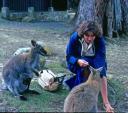One of the things I really wanted to do while I was in Australia was ride horseback across the mountains in Victoria. Perhaps I’d seen the movie The Man from Snow River a few times too often, but I found the near mythic connection with Australian culture and horses to be too hard to resist. So I signed up for a Walhalla Mountain Saddle Safari, which advertised itself as being “not for the faint of heart.” Now, for a girl from the city, that means you’ll be roughing it—a few days without running water, sleeping on the ground, that sort of thing. Well, we were certainly roughing it, but this turned out to be a wild ride. Here, from the book, is a little background on my companions for the adventure.
There were eleven riders in all, with a wide variety of backgrounds, and ages running from 19 to about 45. I was the only American and the least experienced rider of the group. My three months of lessons, which culminated in the rib-breaking fall just prior to my departure for Australia, were ranged against people who own horses, train horses, and even ride daily as part of their work. I was definitely out-classed here. This was not a bunch of weekend hacks out for a romp in the woods. This was a bunch of hardcore riders out for the thrill of a lifetime. Almost everyone had been on one or more of these adventures before. Of course, it added tremendously to my sense of security and well-being when Judy, a veteran of many saddle safaris, donned a crash helmet, noting cheerfully, “My doctor said if I get injured again as badly as I did last time—well, it would be the last time.” (Despite this disheartening introduction, Judy turned out to be both a good friend and the source of most of the botanical information I garnered on this trip.)
The eleven riders include Colin, who is the kind of rider who can pick a flower at a dead gallop; Bradley and Beth, both accomplished equestrians; Jenny and Lisa, sisters from Melbourne, whose only difficulty was adjusting to a saddle, as they usually ride bareback; Mary and Bob, horse owners from near Melbourne; Judy of the white crash helmet, also a local horse owner; Les, a rancher from New South Wales; Carol, one of the few newcomers, but still an experienced rider; and me. We were accompanied by trail boss Malcolm (Mal), who is blond, rugged, handsome, and looks like he belongs here; and Mal’s young but skilled assistant trail bosses, Andrew and Marie. Meeting us most nights with the truck was Debbie, Mal’s wife, a petite, vivacious, pretty brunette.
The only other group members were Rex and Huon. Rex is a shelty and belongs to Mal and Debbie. He traveled with Debbie in the truck. Huon, a probable German shepherd/labrador cross, belongs to Andrew and Marie. He came with us, dashing madly back-and-forth all day long, making sure everything was all right and that no one got lost.








